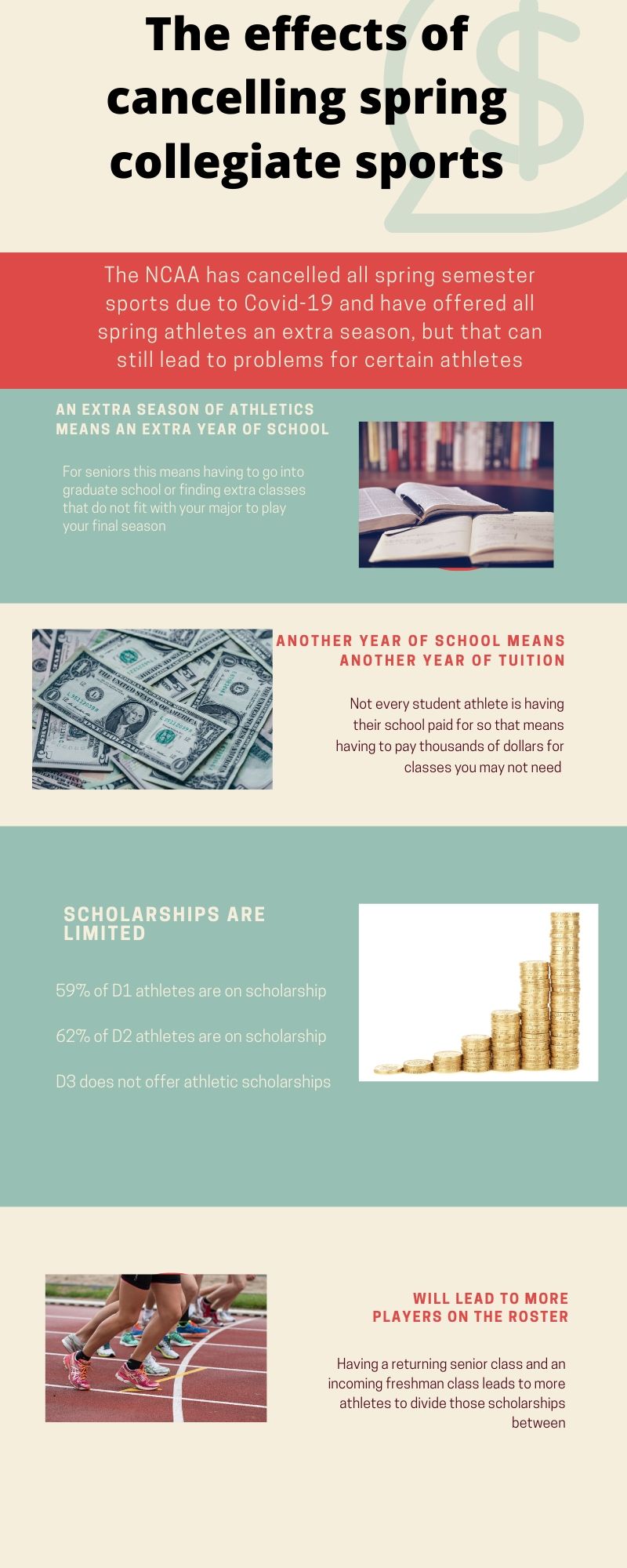
By Brennan Souhrada
The NCAA announced on March 12th that the remainder of all winter and spring athletic seasons in 2020 has been cancelled due to the spread of the Covid-19 virus and all spring sport athletes would receive an extra year of athletic eligibility. This season would be counted as a redshirt season and all spring semester athletes would be eligible for an extra fifth athletic season as opposed to only four, NCAA authorities said in their announcement.
“This decision is based on the evolving COVID-19 public health threat, our ability to ensure the events do not contribute to spread of the pandemic, and the impracticality of hosting such events at any time during this academic year given ongoing decisions by other entities,” the statement reads.
For larger sports such as lacrosse, the season only made it through a few of the out-of-conference games while for smaller sports such as track and tennis, the spring athletic season didn’t even start, and it’s already over.
“It made me very angry and upset,” University of New Hampshire Track and Field runner Marisa Gazzola said, “As a senior who has been training since the summer with the goal of representing my team in the conference championship, it really was a crushing blow to be told that the season was over before it even started. At the time of cancellation, I thought it was an overreaction but I see now that it was necessary,” Gazzola said.
The effects of this cancelation hits the smaller teams just as much as the larger ones. While lacrosse may get more of the attention from this cancelation there are still 314 division 1 women tennis teams that carry anywhere from 8-12 athletes each, according to scholarshipforathletes.com and they are all just as affected by the cancellation as everybody else.
“At first me and all of my teammates were very heartbroken, but I understand now that it had to be down. I think it was very necessary,” Siena University tennis player Anastasia Koniaev said.
While these athletes are being offered another year to play, many of them are not on scholarship. According to the official NCAA website, at the division 1 level 59% of student athletes receive some variation of an athletic scholarship, whether that be a full or partial scholarship, 62% of division 2 athletics receive a variation of an athletic scholarship and division 3 does not give athletic scholarships.
“I am going to take my extra year of eligibility,” Lynn University lacrosse player Xander Cosenza said. “Even though this year was cut short, myself and a teammate were named to an All-American team, we want to be able to come back and build upon that.”
The price tag for non-scholarship athletes to come back can be a hefty one, as according to valuepenguin.com, the average public school tuition is $20,770 and the average private school tuition is $46,950.
While for Cosenza the decision was easy, for others the decision to take an entire extra year of school just for their sport comes down to two big issues, money and the actual school aspect. To take another full two semesters of classes to play in one more athletic season can be a lot for a student athlete to handle.
“I am definitely considering using the extra year of eligibility,” Coker University lacrosse player Matt Murphy said. “But it will be dependent on a lot of different factors such as finances and if attending graduate school would be the best option”
Two extra semesters of classes means two extra semesters of tuition and possible room and board and that leads some athletes to have already ruled out taking an extra year.
“I’m not taking my extra year because it’s too expensive to go to school here for another year,” Mount Saint Mary College lacrosse player Courtney Condron said. “It wouldn’t make sense because I have no other classes to take and they don’t offer grad school for my major.”
One of the biggest spring semester sports is men’s lacrosse. Men’s lacrosse teams at the division 1 level have 44 players on roster but are only given 12.6 scholarships to divide between them, according to scholarshipstats.com this leads to the average scholarship to cover around 30% of the athletes tuition.
“I believe this will create a whole new issue that has to do with scholarships,” Lynn University Cosenza said. “This is because in case of Division II lacrosse, there are only a handful of scholarships that each school has. Bringing in a new freshman class, and keeping some seniors another year will mess up the amount of scholarship that each student and school will have.”
With lower divisions such as division 2 the number of scholarships drop dramatically and division 3 does not offer athletic scholarships. This means that for many of these athletes to come back and play another year of the sport they love, they would have to pay thousands of dollars for classes that they likely would not need to graduate and as Anastasia Koniaev put it simply: “There are always problems when it comes to money.”

